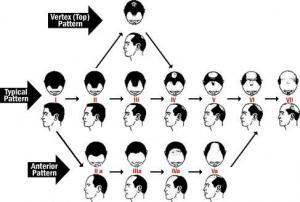Causes of androgenetic alopecia
There are many causes of hair loss but, in the overwhelming majority of males with hair loss, the cause is hereditary Androgenetic Alopecia, more commonly known as “male pattern baldness”. The tendency for male pattern baldness is genetically inherited from either side of the family and begins to develop after puberty. The presence of the hormone Dihydrotestosterone (DHT), in a genetically susceptible man, is necessary for androgenetic alopecia or male pattern baldness to occur.
Please see our section on medical resources regarding the causes and treatments for androgenetic alopecia.
Myths about androgenetic alopecia
Many myths abound about hair loss but it is most definitely NOT caused by poor circulation, clogged hair follicles, frequent shampooing, the wearing of hats and helmets or the presence of mites. Good nutrition can positively affect the quality, but not quantity, of hair. It should also be noted that stress alone does not usually cause hair loss without the presence of the necessary genes and hormones
Cures for androgenetic alopecia
There is no scientifically proven cure for androgenetic alopecia, however there are a number of medically approved treatments and surgical solutions.
Androgenetic alopecia treatment options
There are two FDA approved medications which have proven effective as a hair loss treatment for androgenetic alopecia. The FDA is the Food and Drug Administration in the US.
Hair transplant surgery is a permanent hair loss treatment for men with androgenetic alopecia, the hair that is transplanted is not affected by the balding process as it is taken from the back and sides of the head which are unaffected by the condition. The transplanted hair, once established, will remain on the patient’s head for the rest of their life under normal circumstances.
Hair Classification
The Norwood Classification is the one commonly used for male pattern baldness. There are two basic patterns, the most common of which is where hair loss starts in two different areas – the temples and the crown. Less commonly the loss progresses from front to back.
Non-genetic hair loss from other causes follows a different pattern.










